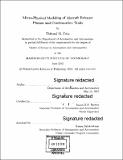Micro-physical modeling of aircraft exhaust plumes and condensation Trails
Author(s)
Fritz, Thibaud Matthieu Martin
DownloadFull printable version (7.558Mb)
Other Contributors
Massachusetts Institute of Technology. Department of Aeronautics and Astronautics.
Advisor
Steven R.H. Barrett.
Terms of use
Metadata
Show full item recordAbstract
The ability to quantitatively assess the environmental impacts of air transport operations is necessary to estimate their current and future impacts on the environment. Emissions from aircraft engines are a significant contributor to atmospheric NOx driving climate change, air quality impacts and other environmental concerns. To quantify these effects, global chemistry-transport models are frequently used. However, such models assume homogeneous and instant dilution into large-scale grid cells and therefore neglect micro-physical processes, such as contrail formation, occurring in aircraft wakes. This assumption leads to inaccurate estimates of NOy partitioning, and thus, an over-prediction of ozone production. To account for non-linear plume processes, a Lagrangian aircraft plume model has been implemented. It includes a unified tropospheric-stratospheric chemical mechanism that incorporates heterogeneous chemistry. Micro-physical processes are considered throughout the entire plume lifetime. The dynamics of the plume are solved simultaneously using an operator splitting method. The plume model is used to quantify how the in-plume chemical composition is affected in response to various environmental conditions and different engine and/or fuel characteristics. Results demonstrate that an instant dilution model overestimates ozone production and accelerates conversion of nitrogen oxides compared to the plume model. Sensitivities to the NOx emission index have been derived and the dependence of the plume treatment on the background atmosphere mixing ratios, pressure and latitude has been investigated for a future regional scale assessment of the aviation sector. The cumulative impact of successive flights has been estimated. Contrail micro-physical and chemical properties have been computed under different scenarios. This aircraft plume model has been extensively validated and enables an in-depth assessment of the impact of one or multiple flights on local atmospheric conditions.
Description
Thesis: S.M., Massachusetts Institute of Technology, Department of Aeronautics and Astronautics, 2018. Cataloged from PDF version of thesis. Includes bibliographical references (pages 63-68).
Date issued
2018Department
Massachusetts Institute of Technology. Department of Aeronautics and AstronauticsPublisher
Massachusetts Institute of Technology
Keywords
Aeronautics and Astronautics.